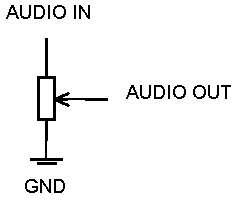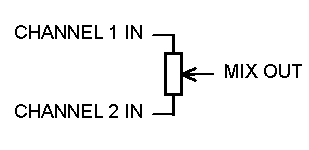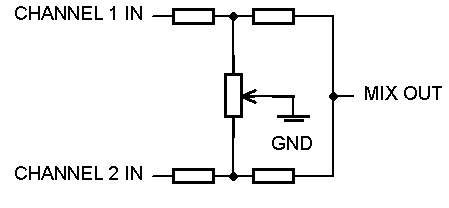Difference between revisions of "Crossfader circuit"
(→Tapped circuit) |
|||
| Line 29: | Line 29: | ||
[[File:Fader_circuit_3.png]] | [[File:Fader_circuit_3.png]] | ||
| − | This has the benefit of only requiring one carbon track per stereo channel, but has issues with impedance and crosstalk, and usually requires buffering on the inputs and outputs. Also, it requires a potentiometer with a [[Wikipedia:Sigmoid]] or "W" taper, which are fairly nonstandard. | + | This has the benefit of only requiring one carbon track per stereo channel, but has issues with impedance and crosstalk, and usually requires buffering on the inputs and outputs. Also, it requires a potentiometer with a [[Wikipedia:Sigmoid|Sigmoid]] or "W" taper, which are fairly nonstandard. |
| − | + | ||
====Ground pulldown==== | ====Ground pulldown==== | ||
Revision as of 21:00, 31 January 2016
Contents
Mixer requirements
Turntablists have the following requirements in a mixer circuit:
- Small off-to-on travel distance - the appropriate channel should be fully muted when the fader is in the zero position, and bring the channel to full volume within the first few millimetres of wiper travel.
- Decay time - when the fader is moved, the appropriate channel should change volume at a rate quickly enough to allow rhythmic cutting, but slowly enough to eliminate any clicks and pops which would be caused by an instantaneous decay
Design Approaches
Early simple circuits
Initial mixer circuits used the crossfader as a component in the audio signal path. This kept the number of components to a minimum, but were very susceptible to wiper noise, and could not support features such as curve control or decay time.
One resistive element per channel
The first crossfader circuits were very simple :
These circuits ran the audio signal through the carbon track, with ground at the other end, and operated like a voltage divider. The wiper pin served as the audio out, and would produce a signal proportional to the distance from the audio source.
This approach required a separate carbon track for each channel, so for two stereo channels four tracks were required. Faders with this configuration were expensive and generated a lot of friction due to the large contact area required.
Tapped circuit
Alternatively, both channels can be connected to the same resistive element, using the wiper as a tap :
This has the benefit of only requiring one carbon track per stereo channel, but has issues with impedance and crosstalk, and usually requires buffering on the inputs and outputs. Also, it requires a potentiometer with a Sigmoid or "W" taper, which are fairly nonstandard.
Ground pulldown
Another topology to consider effectively uses the wiper as a pulldown resistor that can be moved to either channel freely :
This has much reduced crosstalk, but also significantly attenuates the signal, so will adversely affect the signal-to-noise ratio of the circuit. It also requires a sigmoid-taper fader as before.


